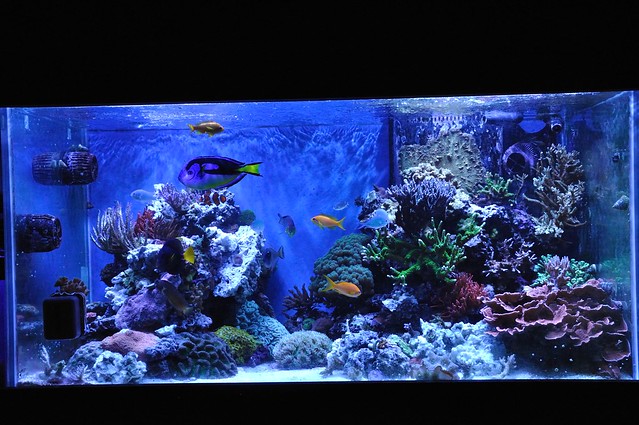I take off 10 minutes early to rush home and figure out what has happened, I have a hunch that the autotop off system has failed and there has been a kalkwasser (lime water) overdose. Sure enough! Luckily only 1/2 gallon of super saturated limewater was pumped into the tank, however, the situation is still quite dire!
I pull water parameters immediately. pH >9 kh~10, so I immediately seek to bring the pH back down to 8.5.
I always have white distilled vinegar on hand for cleaning calcified deposits out of pumps and equipment. Vinegar is acetic acid (CH3COOH <--> CH3COO + H) which should work to lower the pH by increasing hydrogen concentration. I'm working with a 5% concentration of acetic acid.
It's also important to realize that by bacterial processes the remaining CH3COO- will metabolize this organic compound in the following manner; CH3COO- + O2 <--> 2CO2 + H2O + OH- <---> CO2 + H2O + HCO3-
The net result is that an initial addition of acetic acid will produce a drop in pH while the metabolized products will also produce a further drop in pH. Thus it's important not to over shoot the target pH and become overzealous or panic stricken with vinegar additions! Fortunately the metabolized reaction also produces a proportional amount of carbonate to replenish alkalinity lost during the initial dosage.
So what's my next step? I followed some advice offered by Randy Holmes Farley to prevent myself from doing a spot of painful stochiometry in a frantic situation. His recommendation is to use 1ml 5% white distilled vinegar/ gallon of tank water to yeild an initial 0.3 change in pH. Later through metabolic processes an additional 0.3 change.
So I slowly added the vinegar to the sump and at about 10pm had a pH of about 8.65. Then ran to the store for beer (it was going to be a long night) and around 11:30pm I was @ 8.35, things were starting to look a little better;
Finally this morning a fresh batch of salt water I mixed over night (I spent most of the time waiting for my RO system to fill my 35 gallon trash can up) I got in a 35 gallon water change, although things were looking much better already, pH 7.9 (typical) kH~ 3 (too low), after the water change the kH went up to 5, and I was pleased with that for now; (overexposure)
In a couple of days I'm hoping things will be back to normal. Things are looking pretty good, I had one casualty in my frag tank, a royal gramma basslett :( and some corals were looking a little rough around the edges. But as of this afternoon things are looking unscathed really, almost really great aside from all the white residue on the walls. I'm hoping I'll get back to this soon;
Wish me luck!!!!
